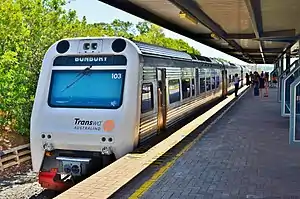Australind (train)
The Australind is a rural passenger train service in Western Australia operated by Transwa on the South Western Railway between Perth and Bunbury.
 An Australind at Bunbury in January 2014 | |||||
| Overview | |||||
|---|---|---|---|---|---|
| Service type | Passenger train | ||||
| Status | Operational | ||||
| Locale | South West Western Australia | ||||
| First service | 24 November 1947 | ||||
| Current operator(s) | Transwa | ||||
| Former operator(s) | WAGR (1947-1975) Westrail (1975-2000) WAGR Commission (2000-2003) | ||||
| Route | |||||
| Start | Perth | ||||
| Stops | 13 | ||||
| End | Bunbury | ||||
| Distance travelled | 167 kilometres | ||||
| Average journey time | 2 hours 30 minutes | ||||
| Service frequency | Twice daily | ||||
| Train number(s) | 9/10 | ||||
| Line(s) used | Armadale Line, South Western Railway, Western Australia | ||||
| Technical | |||||
| Rolling stock | ADP/ADQ class railcars | ||||
| Track gauge | 1,067 mm (3 ft 6 in) | ||||
| |||||
History
The Australind service began on 24 November 1947 and was hauled initially by U class steam locomotives.[1] With an average speed of 63 km/h (39 mph), it was the fastest narrow gauge passenger train in Australia.[2] It was named to commemorate the city of that name envisioned by Marshall Waller Clifton on Leschenault Inlet 100 years previously. The current hamlet of Australind, a satellite town of Bunbury, has never had a passenger rail service, nor even a railway line.
In February 1958, X class diesel locomotives took over. The service was relaunched on 1 October 1960 with onboard catering removing the need for an elongated stop at Pinjarra. On 16 November 1987, the current ADP/ADQ class railcars took over the service reducing journey times to 2 hours 30 minutes.[3][4][5][6]
Rolling stock
When introduced, the train consisted of new carriages built by the Midland Railway Workshops.[4] In August 1985, Westrail awarded Comeng, Bassendean a contract for five Westrail ADP/ADQ class railcars, three ADPs with driving cabs and two ADQs, using a similar body shell and interior fitout to the New South Wales XPT carriages.[7] Each carriage was powered by a Cummins KTA19 coupled to a Voith transmission. They usually operate as a three or four carriage set. Five carriage set operation is not possible due to the limited platform length available at Perth station.[5]
In July 2003, the DMUs were painted in a new livery in line with the formation of Transwa. In 2007, the DMUs were painted white as part of a refurbishment program. In 2010/11, new seats were fitted.[8] Six new Alstom built railcars are scheduled to be delivered in 2022.[9][10]
Route
The Australind departs from Perth traversing the metropolitan Armadale line to Armadale, then the South Western Railway to Bunbury.[11]
See also
References
- "The Australind - Fast Day Train to Bunbury". Kalgoorlie Miner. 26 November 1947. p. 1. Retrieved 10 July 2014.
- Gunzburg, Adrian (1984). A History of WAGR Steam Locomotives. Perth: Australian Railway Historical Society. p. 128. ISBN 0-9599690-3-9.
- Gray, Bill; May, Andrew (2006). A History of WAGR Passenger Carriages. Perth: Bill Gray. pp. 183, 312, 314. ISBN 0-646-45902-3.
- Higham, Geoffrey (2007). Marble Bar to Mandurah: A history of passenger rail services in Western Australia. Bassendean: Rail Heritage WA. pp. 111, 113, 119. ISBN 978-0-9803922-0-3.
- Dunn, John C. (2013). "Perth-Bunbury Railcars". Comeng: A History of Commonwealth Engineering Volume 5, 1985-2012. Dural, NSW: Rosenberg Publishing. pp. 113–122. ISBN 9781925078046.
- "Australind Timetable" (PDF). Transwa. Public Transport Authority. Archived (PDF) from the original on 28 June 2020. Retrieved 28 June 2020.
- "Western Australia" Railway Digest September 1985 page 279
- Annual Report June 2011 Public Transport Authority
- Made in WA: Metronet railcars to be proudly built in WA Minister for Transport 18 August 2019
- Alstom to supply next generation of EMUs to Perth Metro Report International 20 August 2019
- "Our fleet". Public Transport Authority. Perth, WA: Government of Western Australia. Retrieved 5 February 2015.
External links
 Media related to Transwa Australind at Wikimedia Commons
Media related to Transwa Australind at Wikimedia Commons- Perth Trains gallery




